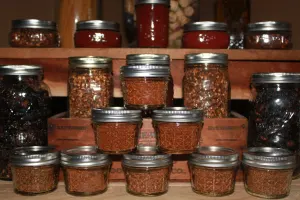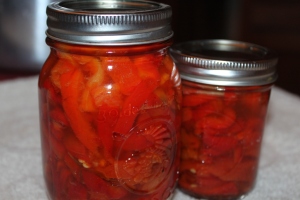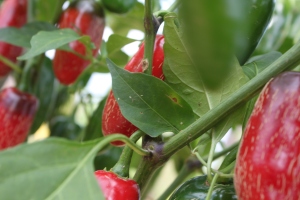The pepper crop in the garden has come to life in the last few weeks. Thankfully – every year – the majority of the peppers seem to come on about two to three weeks after the tomatoes have had their moment in the sun.
I’m not quite sure what we would ever do if they all hit at once!
So as soon our last jars of salsa, tomato juice and pasta sauce have been filled and canned – our attention turns to the pepper crop – and how to preserve them.
We grew a total of 17 varieties of peppers in the garden and landscape this year, with 10 of them being hot, and one of which (poinsettia) we call just plain ridiculously hot :).
California Wonder and Big Bertha Green, Red, Yellow and Orange Bell, Marconi, Italian Roaster, Mariachi, Pimento, Super Cayenne, Chinese Lantern, Jalapeno, Hot Banana, Cajun Belle, Cubanelle, Poinsettia and Sangria all found their way onto the farm this year.
And all of them are now loaded with peppers!

For some of the varieties – such as our hot banana peppers – it’s simple. They are grown solely as the main ingredient for Mary’s Hot Pepper Mustard. (And unfortunately – the only recipe we can’t share – it’s a family secret passed down through Mary’s family 🙂 )
For the green peppers, and the red and yellow bell sweet peppers – freezing is the name of the game.
We slice them up and use a food saver to shrink-wrap them into stir fry packets for use through the winter.
Freezing them whole takes up too much room – and quite honestly – the flavor and texture of frozen whole bell peppers are never the same once frozen.
Roasted Red Peppers – This was a recipe (Roasted Red Pepper Recipe) that Mary featured just a few weeks back – and is an excellent way to enjoy the flavor of your sweet red peppers throughout the year.
They are fantastic in pasta dishes of all kinds – adding intense garden flavor.
Whether it’s homemade jalapeno poppers, stuffed sweet heat Cajun Belles – or spicy stuffed mariachi peppers – we use many of our hot peppers to make some killer appetizers as well as main dishes.
If you really like the heat – you can leave more of the seeds and membrane in – but if you remove – you can really reduce the heat of a completed dish. Hot peppers get their heat and kick from capsaicin, the substance located in the seed pod and in the membrane lining of the pepper’s inner walls.
If you remove that – you remove most of the heat! See : Stuffed Cajun Belle Recipe
Jalapenos : The jalapenos have multiple uses. They are great to east fresh and in salsa – but maybe the most flavorful use is to smoke and make our own chipotle peppers from our red jalapenos late in the season. See: Making Your Own Chipotle Peppers. Just allow your jalapenos to turn red on the vine and you’re ready to go!
We also make a sweet jalapeno recipe (Cowboy Candy) that is really good as a condiment on sandwiches, hot dogs or hamburgers – or even in chili!
My personal favorite is Jalapeno-Chicken Soup. Not only is it spicy and full of flavor – I swear that it can cure the common cold! :). It was one of the first recipes we featured on the blog, and you can find it here : Jalapeno Chicken Soup Recipe.

So last but not least – when we have made everything we can think of and we still have hundreds of peppers left – we make our own pepper flakes and pepper powder!
It is a great way to use up loads of peppers before they go bad – and it’s so simple to do! You can use them to make hot pepper flakes, hot pepper powder, taco seasoning and even chili powder from your own dried hot peppers.
See: Making Your Own Hot Pepper Flakes And Powder. We also make enough to give away to friends and family that love the fresh pepper grind.
Happy Gardening – Mary and Jim
**If you would like to receive our Sunday Farm Update each week – be sure to sign up to follow the blog via email in the right hand column, “like” us on the Facebook, or follow us on Twitter.




